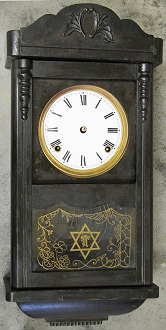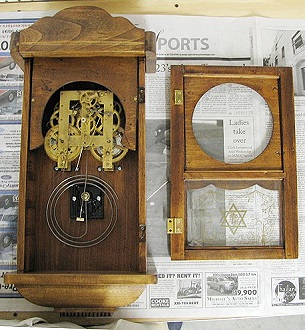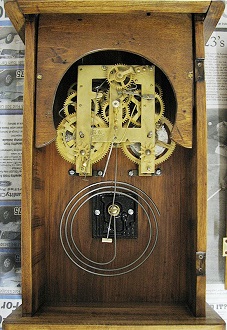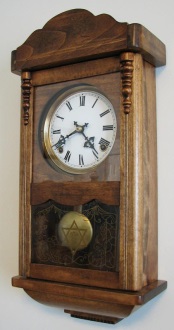Pendulum-Driven Mechanical Clock Escapement |
|
Always wanting to have a pendulum-driven clock with a good old-fashioned mechanical escapement movement, I resorted to eBay to find what I wanted. I'm sure there is a local clock store somewhere around here that would sell me a clock, but I figured a better deal might be had bidding against somebody online than trying to talk a shop owner down in price. Besides, I was really looking for a clock that I could strip down and refinish without worrying about reducing any collector value that it might have. There is a video of it in action at the bottom of the page. After a couple weeks of watching the auctions, I settled on two clocks - one that can sit on a mantel or hang on the wall, and another - the one shown here - that is purely a wall-mounted regulator type. This clock was made in China in 1899, according to a paper that was glued to the back plate. Since this type of clock typically has no real value (they were all cheap imports for working-class people), I performed the stripping and refinishing without regard for preserving any particular features. My goal was to end up with a really nice-looking wooden regulator wall clock with a mechanical, pendulum-driven escapement movement. I suppose technically it is spring-driven, but the pendulum actually regulates the clockworks. The workmanship was very poor, with uneven features and misaligned joints. The movement is also very cheaply made and the gear noise during the chiming is loud, but for the $65 I paid for it, I'll put up with a little noise. A lot of these clocks end up selling on eBay for hundreds of dollars, probably because most people are not aware of their origin and true identity. They all have the same basic appearance, and the movements all have a winged horse on them. Curiously, many (maybe all) of the clocks have a Star of David type of 6-pointed star with a Chinese character in the center trademark stamped. I have two variations of these clocks, and both have similar markings. Watch for a deal if you want one for yourself, but don't pay more than $100 or you will be paying too much - wait for another auction. Crown paint & varnish remover was used to strip the original finish, and then a lot of sanding and scraping completed the denuding process. Unused holes were filled, and some repairs were made to structural components where necessary. The movement got cleaned and oiled, and remounted on the backboard so that it lines up with the dial properly. The clock case was stained with Minwax Special Walnut, and three coats of Deft satin clear acrylic provides the top coat. 000 steel wool was used to smooth out the clear between coats. The brass pendulum bob was cleaned with steel wool and stain clear applied to it, too. While refinishing of the case was under way, the escapement movement was mounted
to a piece of pine and held in a bench vise to work on it. High quality clock oil
from Klockit was applied to
all the pivot points, gear teeth, and the springs, so it should be good to go for
many years. The initial adjustment on the escapement was made during that time,
too. I needed to reshape the verge a bit to get a really strong action on the escapement.
As the video below shows, a perfect tick-tock sound has been achieved. The clock
keeps excellent time, with an adjustment of maybe a minute a week being necessary
to keep in step with my atomic clock that gets its time from the Boulder, CO, signal.
I probably should screw the pendulum bob nut up a half turn to speed it up, but
then what fun would it be is I didn't have an excuse to diddle with the thing? According
to theory, the equation for calculating the period of a simple pendulum is given
by In this case, the length (L) to the approximate center of mass of the pendulum is about 16.5 cm, and g is 981 cm/sec2. So, plugging in the values, the period should be around 0.81 seconds. In fact, it is approximately 0.8 seconds, so here we have theory and real world in agreement. To get more accuracy, I could remove the pendulum assembly (rod + bob) and determine a more precise center of mass distance from the pivot point, and maybe look up the local gravitational constant, but all that work would in search of additional precision be diminished by the fact that there is a 4 cm long section of thin, flexible metal that connects between the pendulum mount on the movement and the top end of the pendulum rod. Its presence changes the equation. I'm pretty happy with the approximation. Judge the actual period for yourself by watching the video. You can watch the escapement in action in this video:
Posted November 4, 2021 |




 .
.